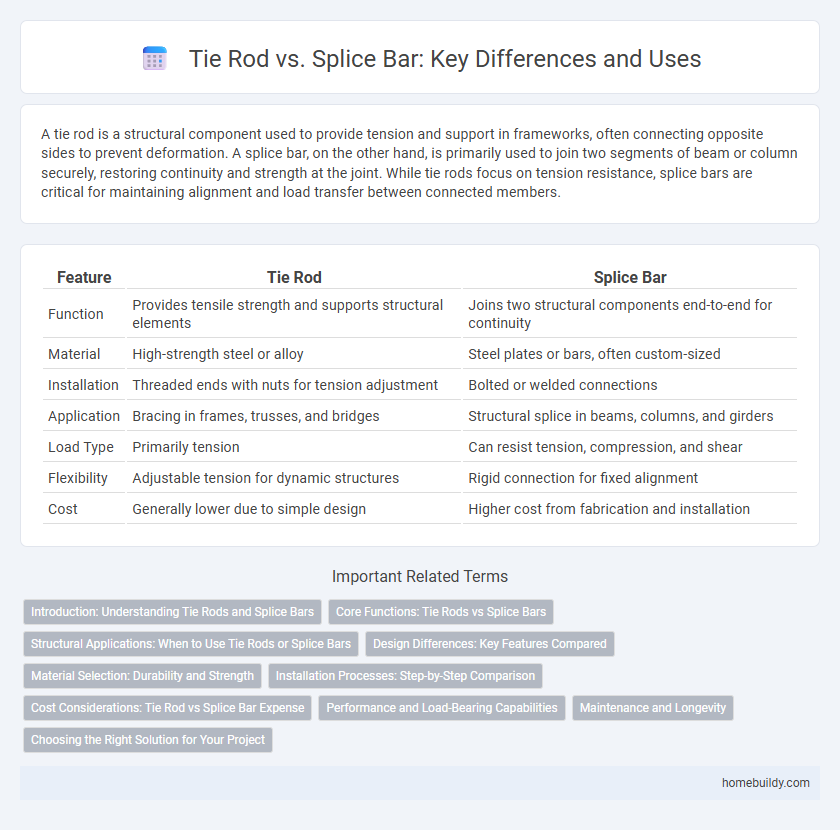A tie rod is a structural component used to provide tension and support in frameworks, often connecting opposite sides to prevent deformation. A splice bar, on the other hand, is primarily used to join two segments of beam or column securely, restoring continuity and strength at the joint. While tie rods focus on tension resistance, splice bars are critical for maintaining alignment and load transfer between connected members.
Table of Comparison
| Feature | Tie Rod | Splice Bar |
|---|---|---|
| Function | Provides tensile strength and supports structural elements | Joins two structural components end-to-end for continuity |
| Material | High-strength steel or alloy | Steel plates or bars, often custom-sized |
| Installation | Threaded ends with nuts for tension adjustment | Bolted or welded connections |
| Application | Bracing in frames, trusses, and bridges | Structural splice in beams, columns, and girders |
| Load Type | Primarily tension | Can resist tension, compression, and shear |
| Flexibility | Adjustable tension for dynamic structures | Rigid connection for fixed alignment |
| Cost | Generally lower due to simple design | Higher cost from fabrication and installation |
Introduction: Understanding Tie Rods and Splice Bars
Tie rods serve as crucial structural components designed to resist tension and maintain alignment in frameworks, while splice bars are metal plates used to join two sections of a tie rod or other structural elements, enhancing strength at the connection point. Tie rods are typically tension members subjected to axial forces, whereas splice bars provide reinforcement by distributing stress over a larger area at joint interfaces. Understanding the distinct roles and mechanical properties of tie rods and splice bars ensures optimal design and durability in construction and machinery applications.
Core Functions: Tie Rods vs Splice Bars
Tie rods primarily provide tensile strength by connecting structural components to resist tension forces, ensuring stability and alignment in frameworks such as bridges and buildings. Splice bars serve as reinforcement elements that join two separate steel sections, distributing loads and maintaining structural continuity under compression and bending stresses. While tie rods focus on tension resistance, splice bars optimize load transfer and enhance joint integrity in steel construction.
Structural Applications: When to Use Tie Rods or Splice Bars
Tie rods are ideal for structural applications requiring tension support in frameworks, providing adjustable and reliable load distribution. Splice bars, however, are better suited for joining or reinforcing columns and beams where compressive or bending loads predominate. Choose tie rods for tensile stability and splice bars for enhancing joint strength in heavy load-bearing structures.
Design Differences: Key Features Compared
Tie rods are slender, tension-only structural components designed to resist tensile forces, typically featuring threaded ends for adjustable connections, whereas splice bars are flat or plate-like elements intended to join or extend structural members primarily in compression and shear. Tie rods emphasize minimal cross-sectional area to efficiently transfer loads, while splice bars focus on providing continuous surface contact and rigidity across the splice joint. The design of tie rods prioritizes tension capacity and adjustability, contrasting with splice bars' role in enhancing joint stiffness and alignment.
Material Selection: Durability and Strength
Tie rods are typically made from high-strength steel alloys that provide excellent tensile strength and durability, essential for withstanding heavy loads and dynamic stresses in structural applications. In contrast, splice bars often use similar steel materials but may include additional surface treatments or coatings to enhance corrosion resistance and prolong service life in harsh environments. Careful material selection directly impacts the longevity and performance of both components, with tie rods prioritizing tensile strength and splice bars balancing strength with protective features for structural continuity.
Installation Processes: Step-by-Step Comparison
Tie rod installation involves aligning the rod through connection points and securing it with nuts or clamps, ensuring tension adjustment for structural stability. Splice bar installation requires positioning the bar over joint sections, followed by bolting or welding to join separate parts firmly. Both methods demand precise alignment and torque application, but tie rods typically allow easier tension adjustments post-installation compared to the more permanent splice bar connections.
Cost Considerations: Tie Rod vs Splice Bar Expense
Tie rods generally offer a cost-effective solution compared to splice bars due to simpler installation processes and lower material expenses. Splice bars may incur higher costs from increased labor and precision requirements during assembly. Evaluating project-specific factors such as load capacity and structural design is essential to determine the most economical choice between tie rods and splice bars.
Performance and Load-Bearing Capabilities
Tie rods offer superior load-bearing capabilities compared to splice bars due to their continuous tensile strength and ability to evenly distribute tension across structural elements. In high-performance applications, tie rods provide enhanced durability and resistance to dynamic stresses, reducing the risk of structural deformation. Splice bars, while useful for connecting segments, generally lack the tensile performance and structural reliability inherent in tie rods under heavy or fluctuating loads.
Maintenance and Longevity
Tie rods require less frequent maintenance compared to splice bars, as their solid construction reduces wear points and potential loosening over time. Splice bars, with multiple bolted connections, demand regular inspections and tightening to prevent joint degradation and ensure structural integrity. Proper maintenance of tie rods directly contributes to extended longevity and consistent performance in load-bearing applications.
Choosing the Right Solution for Your Project
Tie rods provide robust tensile strength and are ideal for structural applications requiring high load-bearing capacity, while splice bars offer enhanced joint stability by securely connecting two components end-to-end. Selecting the right solution depends on project-specific requirements such as load type, alignment precision, and ease of installation. Evaluating factors like material compatibility, maintenance needs, and environmental conditions ensures optimal performance and durability for your construction or engineering project.
tie rod vs splice bar Infographic

 homebuildy.com
homebuildy.com